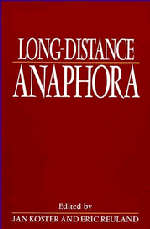Book contents
- Frontmatter
- Contents
- List of contributors
- Preface
- 1 Long-distance anaphora: an overview
- 2 Containment and connectedness anaphors
- 3 Long-distance reflexives and the typology of NPs
- 4 Contextual determination of the anaphor/pronominal distinction
- 5 On the interaction between antecedent-government and binding: the case of long-distance reflexivization
- 6 Binding in Polish
- 7 Anaphors in binary trees: an analysis of Czech reflexives
- 8 Latin long-distance anaphora
- 9 Prepositions, binding and θ-marking
- 10 Locality, parameters and some issues in Italian syntax
- 11 Long-distance binding in Finnish
- 12 The primacy condition of anaphora and pronominal variable binding
- 13 The local nature of the long-distance reflexive in Chinese
- 14 Anaphors and logophors: an argument structure perspective
- References
- Index
9 - Prepositions, binding and θ-marking
Published online by Cambridge University Press: 01 June 2011
- Frontmatter
- Contents
- List of contributors
- Preface
- 1 Long-distance anaphora: an overview
- 2 Containment and connectedness anaphors
- 3 Long-distance reflexives and the typology of NPs
- 4 Contextual determination of the anaphor/pronominal distinction
- 5 On the interaction between antecedent-government and binding: the case of long-distance reflexivization
- 6 Binding in Polish
- 7 Anaphors in binary trees: an analysis of Czech reflexives
- 8 Latin long-distance anaphora
- 9 Prepositions, binding and θ-marking
- 10 Locality, parameters and some issues in Italian syntax
- 11 Long-distance binding in Finnish
- 12 The primacy condition of anaphora and pronominal variable binding
- 13 The local nature of the long-distance reflexive in Chinese
- 14 Anaphors and logophors: an argument structure perspective
- References
- Index
Summary
Introduction
The aim of this chapter is twofold: on one hand I propose an account for the distribution of third person pronouns, clause-bound and long-distance anaphors within PPs; on the other, to explain such distribution, I individuate thematic properties peculiar to prepositions, which differentiate them from other lexical heads such as adjectives and nouns. In this way, some phenomena concerning the behaviour of PPs in small clause constructions, and in predicative contexts in general, will be captured.
In section 2, I analyse the distribution of anaphors and pronouns. In section 3, I present the central hypothesis of this work, i.e. that the behaviour of such elements is related to the thematic properties of prepositions. In sections 4 and 5, I consider the distributions of PPs in small clauses and in predicative constructions. In section 6, I discuss some differences between locative and non-locative prepositions. Finally, I try to handle some potential counterexamples, suggesting that independent principles can account for certain apparent anomalies. This chapter is a portion of a larger work in which I will also consider cross-linguistic evidence (English, Dutch and French), which not only supports my view of the phenomena analysed here, but can also shed light on the peculiarities of the languages considered. In this chapter, for space reasons, I only examine data from Italian, briefly mentioning in a note the most salient aspects in which the other languages diverge.
- Type
- Chapter
- Information
- Long Distance Anaphora , pp. 185 - 208Publisher: Cambridge University PressPrint publication year: 1991
- 4
- Cited by



